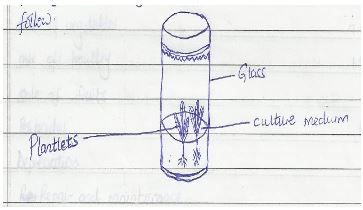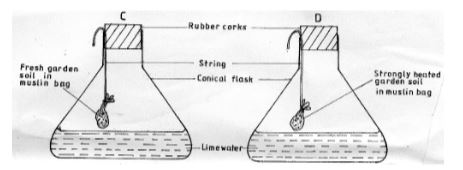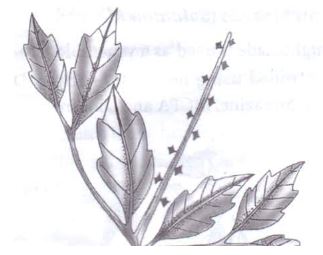SECTION A (30 MARKS
Answer all question in this section in the space provided
- Differentiate between olericulture and pomoculture as used in crop production (1mk)
- List the physical weathering agents in soil formation process (1 ½ mks)
- Give four advantages of crop rotation. (2mk)
- Give two conditions where opportunity cost does not exist (2mrks)
- State four advantages of drip irrigation. (2mks)
- Give four benefits of adding organic manure to sandy soil. (2mks)
- State two forms in which water is available in the soil. (1mk)
- Give four advantages of using seeds over vegetative materials. (2 mks)
- Give four benefits of possessing a land title deed (2mks)
- Give three reasons why primary cultivation should be done early before the onset of the rains (1 ½mks )
- State four features of crops selected in preparation of green manure (2mks)
- Name any four methods of farming in Agriculture (2mks)
- Highlight any four postharvest practices undertaken in cereal crops (2mks)
- Horticultural production can be carried out in several ways name them. (11/2 mks)
- What name is given to the practice of removing of suckers from coffee bushes (1/2 mk)
- State six ways in which soil may lose its fertility. (3 mks)
- Name four categories of vegetables and give an example in each case (2mks)
SECTION B (20 MARKS)
Answer all the questions in this section in the spaces provided
- Given that a maize crop is planted at a spacing of 75cm x 25cm, calculate the plant population in one hectare of land if two seeds are planted per hole. (Show your working). (3mks)
- The diagram below shows a method of crop propagation .Study it and answer the questions that follow.
- Identify the method (1mk)
- Name two crops that can be propagated using this method. ( 2mks)
- Give two ingredients used when preparing tissue culture. (2mks)
- State three advantages of the method above (3mks)
- The diagram below show a set of an experiment to study an aspect of soil. The set up was left undisturbed for twenty four hours (24hrs). Study it and answer the questions that follow.
- What was the aim of the experiment? (1mk)
- State one observation that was made in each conical flasks labeled C and D. (2mks)
- Give a reason for each of your answers in (b) above. (2mks)
C -
D-
- Study the illustration below and answer questions that follow.
- Identify the weed. (1mk)
- Give two harmful effects of the weed illustrated above. (2mks)
- State one reason why tillage is sometimes preferred as a method of weed control. (1mk)
SECTION C (40MARKS)
Answer any two questions in this section in the spaces provided
-
- Explain eight ways in which soil fertility can be maintained (8mks)
- Describe the transplanting of tomato seedlings. (12mks)
-
- Discuss six reasons for pruning coffee (6mks)
- Describe the factors considered when siting a vegetable nursery bed (6mks)
- Explain four factors that determine the spacing to be used in crops (8mks)
-
- Describe five methods of preventing water pollution (5mks)
- Describe the process of water treatment. (10mks)
- Explain five roles of Agriculture in the economy (5mks)
MARKING SCHEME
SECTION A (30 MRKS)
Answer all question in this section in the space provided
- Differentiate between olericulture and pomoculture as used in crop production . (1mk)
- Olericulture –Growing of flowers
- Pomoculture –growing of fruits
- List the physical weathering agents in soil formation process (1 ½ mks)
- Moving ice
- Temperature
- Rainfall
- wind
- Give four advantages of crop rotation . (2mk)
- Improve soil structure
- Control soil borne pest and diseases
- Ensure maximum utilization of farm labour
- Aids in weed control
- Improve soil erosion
- Security in case of failure on one crop
- Add nitrogen through N-fixation by Rhizobium bacterial when legume are included
- Give two conditions where opportunity cost does not exist (2mrks)
- Where there is no alternative
- When the resources are free or a gift
- When the resources are excess or unlimited
- State four advantages of drip irrigation. (2mks)
- Little amount of water is required as compared to other types of irrigation
- Water under low pressure can be used so long as it can flow along the pipe
- It discourages fungal diseases i.e. blight , CBD and others, as it does not wet the leaves
- It does not encourage the growth of weeds between the rows
- Give four benefits of adding organic manure to sandy soil. (2mks)
- Improves microbial activities in the soil
- Increase the nutrient level/ fertility of sandy soil
- Impart dark colour to the soil which help increase soil temperature
- Improves water retention capacity
- Increase soil cation –m exchange capacity , hence PH control
- Reduce leaching
- Improved soil structure by binding together soil particles
- State two forms in which water is available in the soil. (1mk)
- Superfluous water
- Hygroscopic water
- Capillary/available water
- Give four advantages of using seeds over vegetative materials. (2 mks)
- Seeds are not bulky
- Seeds are easy to handle during planting
- Possible to mechanize operations when using seeds
- Seeds are easy to treat against soil borne pests and diseases
- Give four benefits of possessing a land title deed (2mks)
- Name of the owner
- Size of the land
- Land title deed number
- Seal and signature of issuing officer
- Date of registration
- Give three reasons why primary cultivation should be done early before the onset of the rains (1 ½mks )
- Give time for the soil organism to act on organic mater
- Allow gaseous exchange to take place thus carbon dioxide diffuses out of the soil.
- Allows other operations to take place in time.
- State four features of crops selected in preparation of green manure (2mks)
- Fast growth
- Fast to lot
- Leafy
- Preferably leguminous
- Able to grow in poor soil conditions.
- Name any four methods of farming in Agriculture (2mks)
- Mixed farming
- Nomadic pastoralism
- Shifting farming
- Organic farming
- Agro-forestry
- Highlight any four postharvest practices undertaken in cereal crops (2mks)
- Drying
- Dusting/seed dressing
- Sorting and grading
- Processing
- Packaging
- Horticultural production can be carried out in several ways name them. (11/2 mks)
- Floriculture
- Pomoculture
- Olericulture
- What name is given to the practice of removing of suckers from coffee bushes (1/2 mk)
- De-suckering
- State six ways in which soil may lose its fertility. (3 mks)
- Soil erosion
- Soil capping
- Leaching
- Mono cropping
- Continuous cropping
- Change of soil PH
- Burning of land
- Accumulation of salts
- Infestation of weeds.
- Name four categories of vegetables and give an example in each case (2mks)
- Leaf vegetables e.g. kales
- Root vegetables e.g. Carrots
- Fruit vegetables e.g. Tomatoes
- Pod vegetables e.g. French beans
- Stem vegetables e.g. Leeks
- Bulb vegetables e.g. Bulb onions
(Award as a whole if relevant example is given)
SECTION B (20 MRKS)
Answer all the questions in this section in the spaces provided
- Given that a maize crop is planted at a spacing of 75cm x 25cm, calculate the plant population in one hectare of land if two seeds are planted per hole. (Show your working). (3mks)
Plant Population = Area of land x Number of seeds per hole
Spacing of the crop
= 10,000m2 x 2 = 106,666 maize plants
0.75 m x 0.25m
(Award 1 mk for the formula, 1mk for the calculation and 1mk for correct answer). - The diagram below shows a method of crop propagation .Study it and answer the questions that follow
- Identify the method (1mk)
Tissue culture - Name two crops that can be propagated using this method. ( 2mks)
- Bananas
- Eggplant
- Cassava
- yam
- Give two ingredients used when preparing tissue culture. (2mks)
- Growth regulators/hormones i.e. IAA
- Vitamins
- Macro and micronutrients
- Nitrogen and organic supplements e.g. sucrose
- Distilled water
- State three advantages of the method above (3mks)
- It is used to recover and establish pathogen free plants
- It is used in the mass production of propagules
- It is faster in producing plantlets
- Requires less space than the cultural methods of using cuttings which require a bigger space
- Identify the method (1mk)
- The diagram below show a set of an experiment to study an aspect of soil. The set up was left undisturbed for twenty four hours (24hrs). Study it and answer the questions that follow.
- What was the aim of the experiment? (1mk)
- To demonstrate the presence of living organism in the soil.
- State one observation that was made in each conical flasks labeled C and D. (2mks)
- C – Lime water turns white (milky / white precipitate).
- D – No observable change / lime water remains clear.
- Give a reason for each of your answers in (b) above. (2mks)
- C - Lime water is flask C turns water / white precipitate because of CO2 emitted by living organism which reacts with calcium hydroxide to form white precipitate (calcium carbonate), while
- D- The heating of the soil in flask D killed the soil living organism and no respiration occurred to reduce carbon (IV) oxide.
- What was the aim of the experiment? (1mk)
- Study the illustration below and answer questions that follow.
- Identify the weed. (1mk)
- Double thorn
- Give two harmful effects of the weed illustrated above. (2mks)
- Its thorns lower the quality and palatability of pasture / cause injury to livestock
- It irritates workers, thus reducing labour efficiency
- It competes with crops for nutrients, light and space
- It increases the cost of production
- State one reason why tillage is sometimes preferred as a method of weed control. (1mk)
- Loosens the soil/ improves aeration and water infiltration
- It facilitates earthing up in rood crop production
- Crop residues are incorporated into the soil
- It helps control soil – borne pests through exposing them on the surface.
- Identify the weed. (1mk)
SECTION C (40MARKS)
Answer any two questions in this section in the spaces provided
-
- Explain eight ways in which soil fertility can be maintained (8mks)
- Adding manure to the soil to enrich it with nutrients.
- Using inorganic fertilizers which releases nutrients in forms that are readily available to plants.
- Practicing crop rotational to ensure balanced nutrients use.
- Using appropriate tillage, for instance minimum tillage.
- Regulating soil PH though liming
- Controlling soil erosion
- Practicing a forestation and reforestation
- By irrigation which increases availability and uptake of plant nutrients and reclaims saline soil through mulching
- By weeding to reduce competition for nutrients.
- By practicing inter cropping preferably with legume to enhance nitrogen fixation.
- Describe the transplanting of tomato seedlings. (12 mks)
- Should be done when seedlings are pencil size thick (one month old)
- Nursery should be watered before for ease lifting of seedlings
- Use of garden trowel to ensure that seedlings are lifted with lump of soil around roots
- Applying appropriate pesticide on the planting holes and thoroughly mix with the soil
- Lift only healthy and vigorous seedlings
- Plant one seedling per hole at the same depth as was in the nursery
- Transplanting should be done in the evening or on cloudy day
- Provide temporary shade to the transplanted seedling
- Water the seedlings as necessary
- Plan the soul around the seedling and firm
- Holes dug are placed at 60 – 100 cm by 50 – 60 cm
- Transplant onset of rain
- Transport the seedlings carefully /use a wheelbarrow
- Plant holes should be dug at 15 cm deep
- Explain eight ways in which soil fertility can be maintained (8mks)
-
- Discuss six reasons for pruning coffee (6mks)
- To train the plant so that it can have the required shape
- To remove the diseased and the unwanted parts of a plant such as extra suckers ,leaves ,branches ,flowers or even stems
- To control cropping
- To facilitate picking to ease penetration of the spray
- To control pest and diseases
- Describe the factors considered when siting a vegetable nursery bed (6mks)
- Near a water source for easy watering
- In a well sheltered place to prevent strong winds which can uproot seedlings and cause excessive evaporation.
- Security so as to protect them from theft and destruction by animals/birds
- On a gentle slope to prevent erosion through run off and to prevent flooding
- Type of soil, should be fertile and well drained
- Previous cropping. Avoid area where same crop family had been planted to avoid pest and disease attack/build up
- Near the seedbed/main field to minimize damage to seedlings during transplanting
- Accessibility for ease of movement
- Away from shading effect to allow sunshine
- Explain four factors that determine the spacing to be used in crops (8mks)
- Soil fertility.
- The size of the plant.
- Crop stand either pure or mixed.
- Number of seeds per hole.
- Moisture availability
- Use of the crop
- Pest and disease control.
- The type of machinery to be used.
- Discuss six reasons for pruning coffee (6mks)
-
- Describe five methods of preventing water pollution (5mks)
- Soil conservation through construction of terraces
- Fencing water sources
- Use of non-chemical/ methods of pests/ disease/ weed control
- Safe disposal of used farm chemicals and industrial wastes
- Planting grass on water banks
- Proper location of pit latrines
- Controlled use of fertilizers, manure on farms
- Treating and piping water for farm use
- Avoid cultivation during dry and windy periods
- Avoiding cultivation along water sources
- Prohibiting excessive use of agrochemicals
- Using integrated pest management systems
- Using efficient pesticide application techniques
- Use of less toxic pesticide
- Avoid over grazing
- Proper treatment of waste before disposal
- Describe the process of water treatment. (10 mks)
- Filtration at water intake – water leaves the source and is made to pass through a series of sieves before entering the intake pipe. Sieves trap large particles of impurities.
- Softening of water – water circulates and is mixed with soda ash (sodium bicarbonate) and Alum (Aluminium sulphate). The chemicals are added into the water in equal proportions. Soda ash softens the water, while alum helps coagulate solid particles which finally settle down at the bottom of sedimentation tank.
- Coagulation and sedimentation in the coagulation tank which is open, large and circular. Solid particles settle down. Fresh air enters into the water to remove bad smells. Water stays for 36 hours to kill bilharzia worms.
- Filtration in the filtration tank. All remaining solid particles are removed. The tank has layers of different sizes of gravel and a top layer of sand.
- Chlorination – Filtered water enters the chlorination tank where a small amount of chlorine solution is added by use of dosers. Chlorine kills micro organisms in water.
- Storage – Water is stored in a large tank before distribution. The tank should be properly covered and the area around it well fenced.
- Explain five roles of Agriculture in the economy (5mks)
- A source of food supply: This sector supplies food to the population. It ensures healthy and strong people who participate in economic development activities/money saved is used on other economic activities.
- It is a source of employment: This sector provides direct employment to over 70% of Kenya’s population. Some are directly employed as farmers or farm workers while others are indirectly employed in the agro-based industries.
- It is a foreign exchange earner for the country: Agriculture products such as coffee, tea, pyrethrum, horticultural products, and livestock products from Kenya are exported to other countries. After exporting these they earn the country foreign currency which in turn is used to import other products such as machinery/saves money which would have been used for buying these commodities.
- It is a source of raw materials for industries: Most of agricultural products require processing before use. Industries such as rice mills, breweries, canning factories and leather tanning have been set up to process such products.
- It provides a market for industrial goods: Agriculture sector provides a market for industrial goods such as chemicals, tools, and equipment.
- Describe five methods of preventing water pollution (5mks)
Download Agriculture Paper 1 Questions and Answers - Form 3 Term 3 Opener Exams 2023.
Tap Here to Download for 50/-
Get on WhatsApp for 50/-
Why download?
- ✔ To read offline at any time.
- ✔ To Print at your convenience
- ✔ Share Easily with Friends / Students




